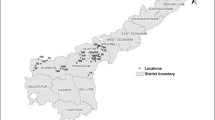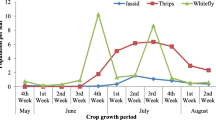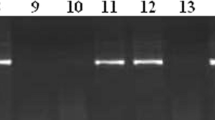Abstract
Pink bollworm (Pectinophora gossypiella) is recognized as an important pest of cotton and can damage flowers and bolls of both Bt and non-Bt cultivars. Cry-1Ac in Bt cultivars is considered very effective in controlling lepidopterous larvae; therefore, the present study was carried out to investigate the impact of Cry1-Ac and the earliness index on the natural incidence of P. gossypiella at the Cotton Research Institute, Faisalabad. During 2015–2016, ten cultivars were used to determine the incidence of pink bollworm infestation. The experiment was repeated for 2 years. During the next year, Cry1-Ac and earliness traits of selected cultivars were also observed to determine their impact on pink bollworm. Correlation coefficient results regarding days to first flower (r value = 0.66) as well as the earliness index (r value = − 0.62) exhibited a strong association with pink bollworm, but Cry1-Ac had a weak association (r value = − 0.058) with pink bollworm. The coefficient of determination (R 2) explained that variability of pink bollworm due to Cry1-Ac, the earliness index, and days to first flower was 18.0, 38.5, and 43.5%, respectively. Principal component analysis results showed that the first two PCs expressed 87% of the total variability. Clusters made on the basis of the studied parameters revealed that clusters 2 and 3 comprised the cotton cultivars possessing earliness traits compared with cluster 1. Therefore, it can be concluded that the earliness index in cotton is an important component for the sustainable management of pink bollworm infestation, the need for which is endless to evade the pink bollworm problem in the era of climate change.

Similar content being viewed by others
References
Adamczyk J, Hardee D, Adams L, Sumerford D (2001) Correlating differences in larval survival and development of bollworm (Lepidoptera: Noctuidae) and fall armyworm (Lepidoptera: Noctuidae) to differential expression of Cry1-A (c) δ-endotoxin in various plant parts among commercial cultivars of transgenic Bacillus thuringiensis cotton. J Econ Entomol 94:284–290
Arshad M, Suhail A (2011) Field and laboratory performance of transgenic Bt cotton containing Cry1-Ac against beet armyworm larvae (Lepidoptera: Noctuidae) Pakistan. J Zool 43:529–535
Attique M, Ahmad M, Ahmad Z, Rafiq M (2001) Sources of carry-over and possibilities of cultural control of Pectinophora gossypiella (Saunders) in the Punjab. Pak Crop Prot 20:421–426
Bednarz CW, Nichols RL (2005) Phenological and morphological components of cotton crop maturity. Crop Sci 45:1497–1503
Cardé RT, Staten RT, Mafra-Neto A (1998) Behaviour of pink bollworm males near high-dose, point sources of pheromone in field wind tunnels: insights into mechanisms of mating disruption. Entomol Exp Appl 89:35–46
Carriere Y, Ellers-Kirk C, Sisterson M, Antilla L, Whitlow M, Dennehy TJ, Tabashnik BE (2003) Long-term regional suppression of pink bollworm by Bt cotton. Proc Natl Acad Sci 100:1519–1523
Carrière Y, Ellers-Kirk C, Biggs R, Higginson DM, Dennehy TJ, Tabashnik BE (2004) Effects of gossypol on fitness costs associated with resistance to Bt cotton in pink bollworm. J Econ Entomol 97:1710–1718
Carrière Y et al (2005) Effects of cotton cultivar on fitness costs associated with resistance of pink bollworm (Lepidoptera: Gelechiidae) to Bt cotton. J Econ Entomol 98:947–954
Chen C, Bauske E, Musson G, Rodriguezkabana R, Kloepper J (1995) Biological control of Fusarium wilt on cotton by use of endophytic bacteria. Biol Control 5:83–91
Chu C-C et al (1996) Reduction of pink bollworm (Lepidoptera: Gelechüdae) populations in the Imperial Valley, California, following mandatory short-season cotton management systems. J Econ Entomol 89:175–182
Dhurua S, Gujar GT (2011) Field-evolved resistance to Bt toxin Cry1-Ac in the pink bollworm, Pectinophora gossypiella (Saunders) (Lepidoptera: Gelechiidae), from India. Pest Manag Sci 67:898–903
Doane CC, Brooks TW (1981) Research and development of pheromones for insect control with emphasis on the pink bollworm. In: Mitchell ER (ed) Management of insect pests with semiochemicals. Springer, New York, pp 285–303
El Tigani M, Ahmed MA (1991) Strategies for integrated cotton pest control in the Sudan. 1—Cultural and legislative measures. Int J Trop Insect Sci 12:547–552
Faircloth WH, Patterson MG, Monks CD, Goodman WR (2001) Weed management programs for glyphosate-tolerant cotton (Gossypium hirsutum). Weed Technol 15:544–551
Faust RM, Koul O, Cuperus G, Elliot N (2008) General introduction to areawide pest management. In: Faust RM (ed) Areawide pest management theory and implementation. CAB International, Cambridge, pp 1–14
Fife L, Robertson O, Graham H (1963) Winter carryover of the pink bollworm under various cultural practices in central Texas. J Econ Entomol 56:172–175
Flint H, Wilson F, Hendrix D, Leggett J, Naranjo S, Henneberry T, Radin J (1994) The effect of plant water stress on beneficial and pest insects including the pink bollworm and the sweetpotato whitefly in two short-season cultivars of cotton. Southwest Entomol 19:11
González-Cabrera J, Escriche B, Tabashnik BE, Ferré J (2003) Binding of Bacillus thuringiensis toxins in resistant and susceptible strains of pink bollworm (Pectinophora gossypiella). Insect Biochem Mol Biol 33:929–935
Gore J, Leonard B, Adamczyk J (2001) Bollworm (Lepidoptera: Noctuidae) survival on ‘Bollgard’ and ‘Bollgard II’ cotton flower bud and flower components. J Econ Entomol 94:1445–1451
Greenplate JT (1999) Quantification of Bacillus thuringiensis insect control protein Cry1-Ac over time in Bollgard cotton fruit and terminals. J Econ Entomol 92:1377–1383
Gutierrez AP, D’Oultremont T, Ellis C, Ponti L (2006) Climatic limits of pink bollworm in Arizona and California: effects of climate warming. Acta Oecol 30:353–364
Henneberry TJ, Naranjo SE (1998) Integrated management approaches for pink bollworm in the southwestern United States integrated pest management reviews 3:31–52
Hughs S, Staten R (1995) Pink bollworm mortality using large-diameter, gin-trash fans. Appl Eng Agric 11:281–284
Iqbal M, Chang MA, Jabbar A, Iqbal MZ, Hassan M, Islam N (2003) Inheritance of earliness and other characters in upland cotton. Online J Biol Sci 3:585–590
Jin L, Zhang H, Lu Y, Yang Y, Wu K, Tabashnik BE, Wu Y (2015) Large-scale test of the natural refuge strategy for delaying insect resistance to transgenic Bt crops. Nat Biotechnol 33:169–174
Kranthi K, Dhawad C, Naidu S, Mate K, Patil E, Kranthi S (2005a) Bt-cotton seed as a source of Bacillus thuringiensis insecticidal Cry 1 Ac toxin for bioassays to detect and monitor bollworm resistance to Bt-cotton. Curr Sci 88:796–800
Kranthi KR et al (2005b) Temporal and intra-plant variability of Cry1-Ac expression in Bt-cotton and its influence on the survival of the cotton bollworm, Helicoverpa armigera (Hübner) (Noctuidae: Lepidoptera). Curr Sci 89:291–298
Li C et al (2013) QTL analysis for early-maturing traits in cotton using two upland cotton (Gossypium hirsutum L.) crosses. Breed Sci 63:154–163
Liao C, Heckel DG, Akhurst R (2002) Toxicity of Bacillus thuringiensis insecticidal proteins for Helicoverpa armigera and Helicoverpa punctigera (Lepidoptera: Noctuidae), major pests of cotton. J Invertebr Pathol 80:55–63
Liu Y-B, Tabashnik BE, Dennehy TJ, Patin AL, Sims MA, Meyer SK, Carrière Y (2001) Effects of Bt cotton and Cry1-Ac toxin on survival and development of pink bollworm (Lepidoptera: Gelechiidae). J Econ Entomol 94:1237–1242
Martins ÉS et al (2007) Characterization of Bacillus thuringiensis isolates toxic to cotton boll weevil (Anthonomus grandis). Biol Control 40:65–68
Masson L, Tabashnik BE, Liu Y-B, Brousseau R, Schwartz J-L (1999) Helix 4 of the Bacillus thuringiensis Cry1-Aa toxin lines the lumen of the ion channel. J Biol Chem 274:31996–32000
Mohan KS, Ravi KC, Suresh PJ, Sumerford D, Head GP (2016) Field resistance to the Bacillus thuringiensis protein Cry1-Ac expressed in Bollgard® hybrid cotton in pink bollworm, Pectinophora gossypiella (Saunders), populations in India. Pest Manag Sci 72:738–746
Olsen K, Daly J, Holt H, Finnegan E (2005) Season-long variation in expression of Cry1-Ac gene and efficacy of Bacillus thuringiensis toxin in transgenic cotton against Helicoverpa armigera (Lepidoptera: Noctuidae). J Econ Entomol 98:1007–1017
Saleem M, Shakeel A, Bilal M, Shahid M, Anjum S (2010) Effect of different phosphorus levels on earliness and yield of cotton cultivars. Soil Environ 29:128–135
Shah MKN, Malik SA, Murtaza N, Ullah I, Rahman H, Younis U (2010) Early and rapid flowering coupled with shorter boll maturation period offers selection criteria for early crop maturity in upland cotton. Pak J Bot 42:3569–3576
Shahid MR, Farooq M, Shakeel M, Mahmood A, Gogi MD (2017) Impact of Dysdercus koenigii Fabricius (Hemiptera: Pyrrhcoridae) density-dependent population on agronomic and qualitative characteristics of different transgenic cotton varieties. Phytoparasitica 45:1–9
Shakeel A, Azhar FM, Khan IA (2008) Assessment of earliness in Gossypium hirsutum L. Pak J Agric Sci 45:80–87
Sharma R, Rice R, Reynolds H, Shorey H (1971) Seasonal influence and effect of trap location on catches of pink bollworm 1 males in sticky traps baited with hexalure 2. Ann Entomol Soc Am 64:102–105
Singh B (2006) Recent progress in cowpea genetics and breeding. In: I International Conference on Indigenous Vegetables and Legumes. Prospectus for Fighting Poverty, Hunger and Malnutrition 752, pp 69–76
Slosser J (1993) Influence of planting date and insecticide treatment on insect pest abundance and damage in dryland cotton. J Econ Entomol 86:1213–1222
Sneath PH, Sokal RR (1973) Numerical taxonomy. The principles and practice of numerical classification. W.H. Freeman and Co, San Francisco
Solis P, Torrent J (1989) Phosphate sorption by calcareous vertisols and inceptisols of Spain. Soil Sci Soc Am J 53:456–459
Stewart S, Adamczyk J, Knighten K, Davis F (2001) Impact of Bt cottons expressing one or two insecticidal proteins of Bacillus thuringiensis Berliner on growth and survival of noctuid (Lepidoptera) larvae. J Econ Entomol 94:752–760
Wan P, Zhang Y, Wu K, Huang M (2005) Seasonal expression profiles of insecticidal protein and control efficacy against Helicoverpa armigera for Bt cotton in the Yangtze River valley of China. J Econ Entomol 98:195–201
Wang S, Guo A, Zheng W, Zhang Y, Qiao H, Kennedy I (2007) Development of ELISA for the determination of transgenic Bt-cottons using antibodies against Cry1-Ac protein from Bacillus thuringiensis HD-73. Eng Life Sci 7:149–154
Wilson FD (1991) Combining ability for yield characteristics and earliness of pink bollworm-resistant cotton. Crop Sci 31:922–925
Acknowledgement
The constant support of the field assistant Muhammad Riaz in allocation of treatments and other elements of the experiments is highly appreciated.
Author information
Authors and Affiliations
Corresponding author
Additional information
Handling Editor: Ritu Chaudhary.
Rights and permissions
About this article
Cite this article
Shahid, M.R., Shakeel, M., Farooq, M. et al. Earliness index deters Pectinophora gossypiella incidence on advanced cultivars of Bt cotton. Arthropod-Plant Interactions 12, 303–309 (2018). https://doi.org/10.1007/s11829-017-9577-6
Received:
Accepted:
Published:
Issue Date:
DOI: https://doi.org/10.1007/s11829-017-9577-6




